 | |
China | Romania |
|---|---|
The Kingdom of Romania and Republic of China (ROC) began relations on July 5, 1939.
 | |
China | Romania |
|---|---|
The Kingdom of Romania and Republic of China (ROC) began relations on July 5, 1939.
Following the takeover of the capital of Nanking in 1941, Romania broke off relations with the ROC and began recognizing the Japanese-backed Chinese Republic. After the surrender of Japan, relations between the two never resumed, but after the Chinese Communists seized power in 1949 and Romania abolished the monarchy in 1947, the Romanian People's Republic recognized People's Republic of China (PRC) as the legitimate government of China on October 5 of that year. China and Romania exchanged ambassadors for the first time in March 1950.
When the Soviet Union and many other European communist countries withdrew their advisors from China in 1960, advisors from Yugoslavia were among those that remained. [1] : 243
Relations between the Romania and China improved after Romania broke off ties with the Soviet Union in 1964.
The PRC operates an embassy in Bucharest and a consulate general in Constanța. Romania has an embassy in Beijing and 2 consulates general in Hong Kong and Shanghai. The modern-day Republic of China (Taiwan) has no official diplomatic relations with Romania, although it is represented by Hungary via the Hungarian Trade Office in Taipei and the ROC through the Taipei Economic and Cultural Office in Budapest.
In 2015, Romania signed an agreement with China General Nuclear Power Group for assistance in building civil nuclear power stations. [2] When the National Liberal Party came into power, it cancelled all projects that the Social Democratic Party government had agreed to with China, including the nuclear power agreement, [3] : 164 which Romania cancelled in 2020. [4] [5]
Romania hosts four Confucius Institutes. [3] : 165
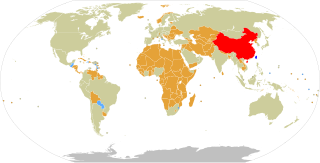
Taiwan, currently has formal diplomatic relations with 12 of the 193 United Nations member states and with the Holy See, which governs Vatican City, as of 3 December 2023. In addition to these relations, Taiwan also maintains unofficial relations with 59 UN member states, one self-declared state (Somaliland), three territories, and the European Union via its representative offices and consulates under the One China principle. The government of Taiwan has the 31st largest diplomatic network in the world with 110 offices.

The Taiwan Relations Act is an act of the United States Congress. Since the formal recognition of the People's Republic of China, the Act has defined the officially substantial but non-diplomatic relations between the US and Taiwan.

The Sino-Soviet split was the gradual deterioration of relations between China and the Soviet Union caused by doctrinal divergences that arose from their different interpretations and practical applications of Marxism–Leninism, as influenced by their respective geopolitics during the Cold War of 1947–1991. In the late 1950s and early 1960s, Sino-Soviet debates about the interpretation of orthodox Marxism became specific disputes about the Soviet Union's policies of national de-Stalinization and international peaceful coexistence with the Western Bloc, which Chinese founding father Mao Zedong decried as revisionism. Against that ideological background, China took a belligerent stance towards the Western world, and publicly rejected the Soviet Union's policy of peaceful coexistence between the Western Bloc and Eastern Bloc. In addition, Beijing resented the Soviet Union's growing ties with India due to factors such as the Sino-Indian border dispute, and Moscow feared that Mao was too nonchalant about the horrors of nuclear warfare.

The Taipei Economic and Cultural Representative Office (TECRO), also known as Taipei Economic and Cultural Office (TECO), Taipei Representative Office (TRO) or Taipei Mission, is an alternative diplomatic institution serving as a de facto embassy or a consulate of the Republic of China to exercise the foreign affairs and consular services in specific countries which have established formal diplomatic relations with the People's Republic of China. As the PRC denies the legitimacy of the ROC as a sovereign state and claims the ROC-controlled territories as an integral part of its China. An exclusive mandate namely One-China policy, mandates any country that wishes to establish a diplomatic relationship with the PRC must first sever any formal relationship with the ROC. According to The Fletcher Forum of World Affairs, "non-recognition of the Taiwanese government is a prerequisite for conducting formal diplomatic relations with the PRC—in effect forcing other governments to choose between Beijing and Taipei." As a result, these countries only allow the ROC to establish representative offices instead of a fully-fledged embassy or consulate for the purpose of conducting practical bilateral relations without granting full diplomatic recognition.

The Canadian Trade Office in Taipei is Canada's trade office in Taiwan, which functions as a de facto embassy in the absence of official diplomatic relations in which Canada recognized the People's Republic of China in October 1970 in accordance with the one-China policy.

Since its founding in 1949, the People's Republic of China (PRC) has had a diplomatic tug-of-war with its rival in Taiwan, the Republic of China (ROC). Throughout the Cold War, both governments claimed to be the sole legitimate government of all China and allowed countries to recognize either one or the other. Until the 1970s, most Western countries in the Western Bloc recognized the ROC while the Eastern Bloc and Third World countries generally recognized the PRC. This gradually shifted and today only 12 UN member states recognize the ROC while the PRC is recognized by the United Nations, 180 UN member states and the State of Palestine as well as Cook Islands and Niue. Both the ROC and the PRC maintain the requirement of recognizing its view of the One China policy to establish or maintain diplomatic relations. The United Kingdom did recognize the PRC in 1950 but an exchange of Ambassadors was refused by the PRC until 1972.
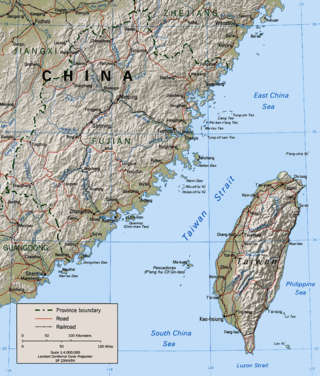
The Second Taiwan Strait Crisis, also called the 1958 Taiwan Strait Crisis, was a conflict that took place between the People's Republic of China (PRC) and the Republic of China (ROC). In this conflict, the PRC shelled the islands of Kinmen (Quemoy) and the Matsu Islands along the east coast of mainland China in an attempt to take control of Taiwan from the Chinese Nationalist Party, also known as the Kuomintang (KMT), and to probe the extent of the United States defense of Taiwan's territory. A naval battle also took place around Dongding Island when the ROC Navy repelled an attempted amphibious landing by the PRC Navy.

The Formosa Resolution of 1955 was a joint resolution passed by the U.S. Senate and signed by U.S. President Dwight D. Eisenhower on January 29, 1955, to counteract the threat of an invasion of Taiwan by the People's Republic of China (PRC). The resolution gave the U.S. president the authority "to employ the Armed Forces of the United States as he deems necessary for the specific purpose of securing and protecting Formosa and the Pescadores against armed attack [by the Communists]".
An exclusive mandate is a government's assertion of its legitimate authority over a certain territory, part of which another government controls with stable, de facto sovereignty. It is also known as a claim to sole representation or an exclusive authority claim. The concept was particularly important during the Cold War period when a number of states were divided on ideological grounds.
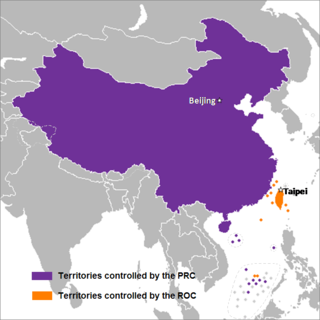
The term "Two Chinas" refers to the geopolitical situation where two political entities exist under the name "China".
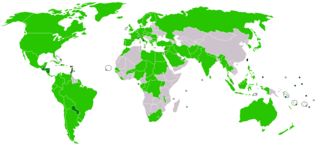
Numerous states have ceased their diplomatic recognition of the Republic of China during the last 70 years, since the founding of the People's Republic of China. Under the One China policy, the ROC is recognized by 12 UN member states and Holy See with 59 UN member states and Somaliland maintaining unofficial cultural and economic relations.
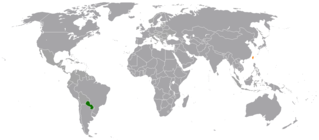
Paraguay–Taiwan relations, also known as Sino–Paraguayan relations or Paraguayan–Taiwanese relations are foreign relations between the Republic of Paraguay and the Republic of China (Taiwan). Both governments established diplomatic relations on 8 July 1957.

Russia–Taiwan relations or Taiwan–Russia relations are the bilateral foreign relations between Taiwan and Russia. Due to the 2022 Russian invasion of Ukraine, In a 2023 survey, 95% of Taiwanese people held a negative view of Russia and China. The relations became tense after Taiwan imposed sanctions against Russia. Russia placed Taiwan on a list of "unfriendly countries", along with South Korea, Japan, Singapore, the United States, European Union members, NATO members, Canada, Australia, New Zealand, Norway, Switzerland, Micronesia and Ukraine.

Diplomatic relations between China and the Federated States of Micronesia were established on September 11, 1989. The Chinese government first established an embassy in the capital of Palikir in 1990, and dispatched its first ambassador in 1991. In April 2023, the Chinese government allegedly threatened to assassinate the Micronesian president, David Panuelo, and so, Micronesia severed official relations between the two countries. It said it decided to increase relations with Taiwan and it accused China of bribing officials and trying to control the United States’ influence in the region. Initially, the Micronesian ambassador to Tokyo, Japan also served as Micronesia's ambassador to China, before Micronesia established an embassy in Beijing in 2007. President John Haglelgam was the first senior government agent from Micronesia to visit China, doing so in 1990. The current Chinese ambassador to Micronesia is Zhang Weidong, while the Micronesian ambassador to Beijing is Akillino H. Susaia.

South Africa–Taiwan relations, also before 1998: Republic of China–South Africa relations refers to the current and historical relationship between the Republic of China (Taiwan) and the Republic of South Africa. The Republic of China and South Africa established diplomatic ties in 1949.

Latvia–Taiwan relations, also retroactively known as ROC–Latvian relations date back to August 16, 1923, when the Republic of China recognized Latvia de jure, in that period when the island of Taiwan was under Japanese colonial rule. After the Soviet occupation of Latvia in 1940, the ROC is one of the few countries that did not recognize Latvia's incorporation into the Soviet Union.

Cooperation between China and Central and Eastern European Countries is an initiative by the Chinese Ministry of Foreign Affairs to promote business and investment relations between China and 14 countries of Central and Eastern Europe : Albania, Bosnia and Herzegovina, Bulgaria, Croatia, the Czech Republic, Greece, Hungary, Montenegro, North Macedonia, Poland, Romania, Serbia, Slovakia, and Slovenia. Prior to their 2022 withdrawal, Estonia, Latvia, and Lithuania were members of the initiative.
The People's Republic of China emerged as a great power and one of the three big players in the tri-polar geopolitics (PRC-US-USSR) during the Cold War, after the Korean War in 1950-1953 and the Sino-Soviet split in the 1960s, with its status as a recognized nuclear weapons state in 1960s. Currently, China has one of the world's largest populations, second largest GDP (nominal) and the largest economy in the world by PPP. China is now considered an emerging global superpower.
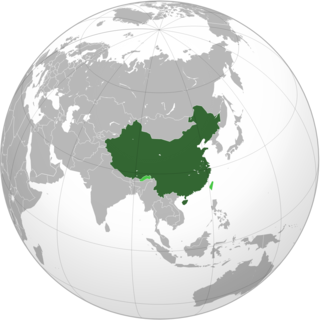
China–Yugoslavia relations were historical foreign relations between China and now split-up Socialist Federal Republic of Yugoslavia. For a long period during the Cold War China was critical towards perceived excessive liberalism, too close cooperation with Western Bloc or market socialism of Yugoslavia, therefore the Chinese communists accused the Yugoslav communists of being revisionists, while the Yugoslav communists accused the Chinese communists of being dogmatics. But, the good relations between both socialist states were restored at the end of the 1960s, and improved even more since the Sino-Albanian rupture occurred, with the trend of improved relations continuing in relations with successor states, particularly Serbia. In the 1980s Deng Xiaoping's foreign policy resembled Yugoslavia's stance of being non-aligned and non-confrontational and with Hu Yaobang’s 1983 appraisal of ‘Josip Tito's principles of independence and equality among all communist parties, and of opposing imperialism, colonialism, and hegemonism’. All six former Yugoslav republics have memoranda of understanding with China on Belt and Road Initiative.